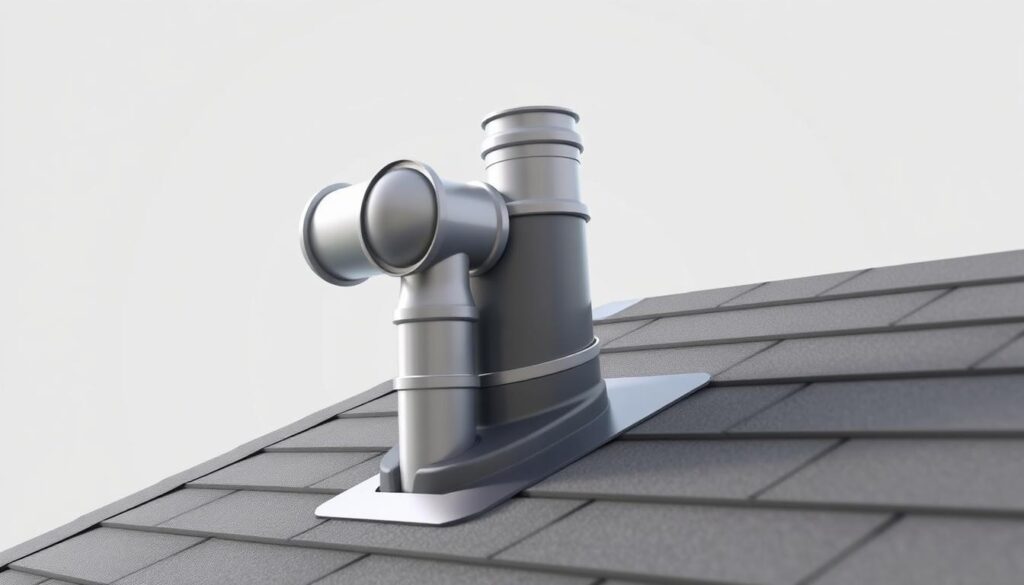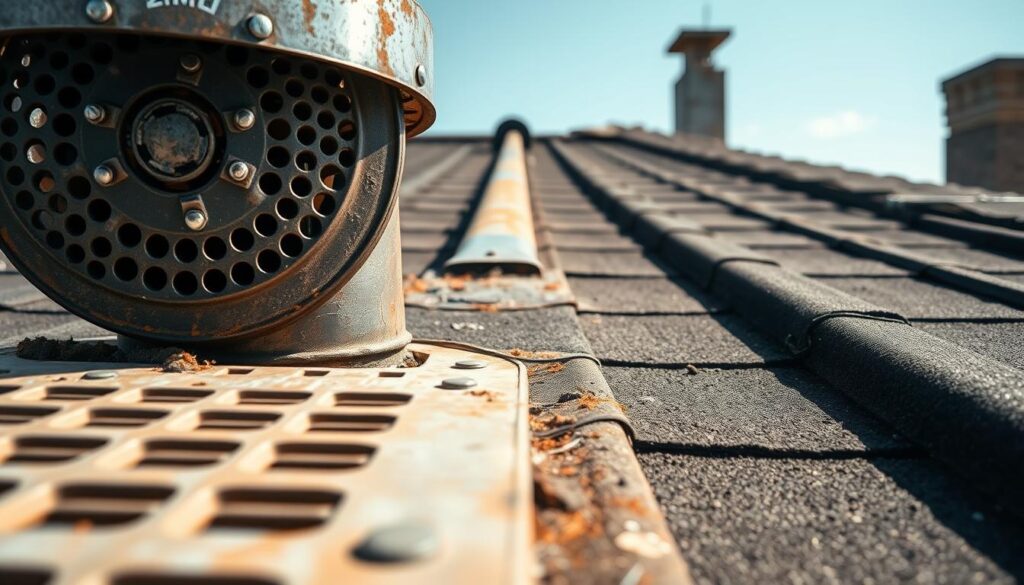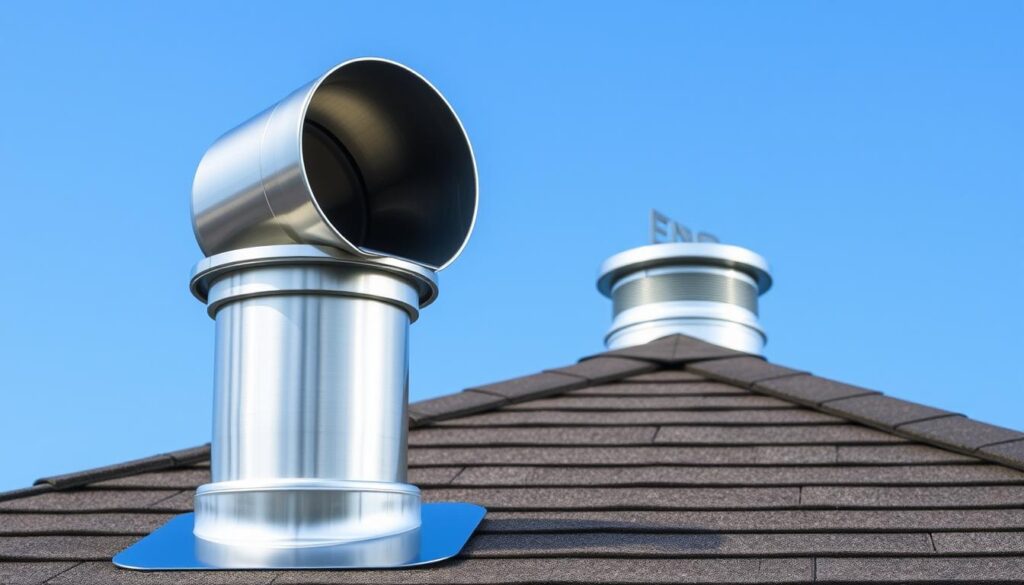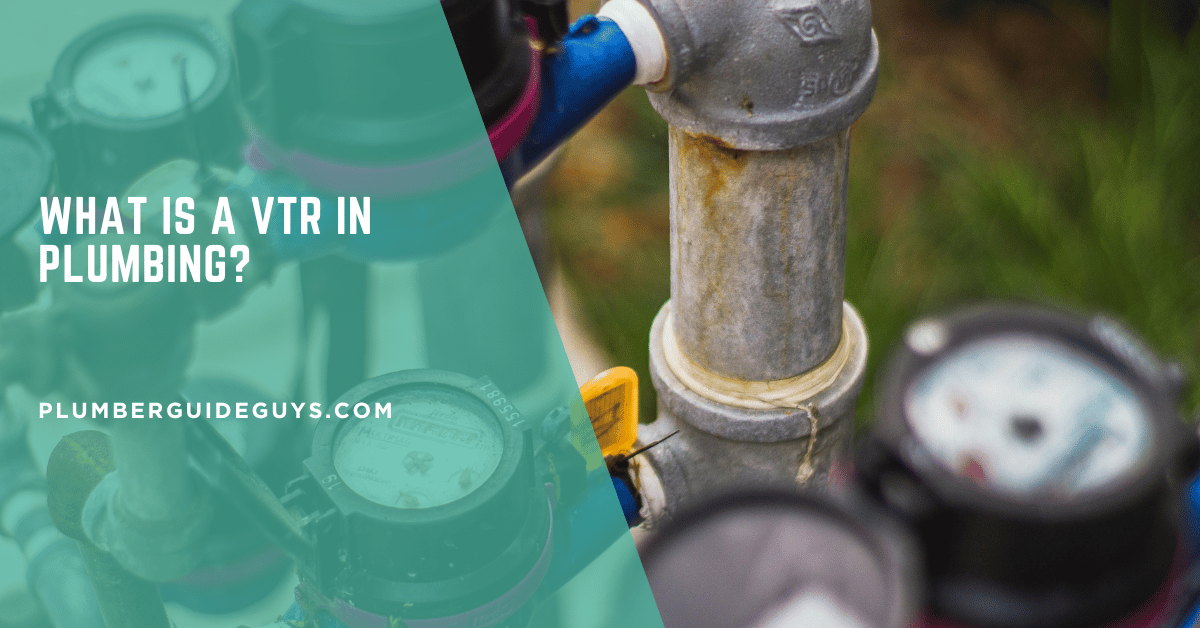Affiliate Disclosure
Plumber Guide Guys is a participant in the Amazon Services LLC Associates Program, an affiliate advertising program designed to provide a means for sites to earn advertising fees by advertising and linking to Amazon.
What is a VTR in Plumbing? Ever wondered how your home’s plumbing keeps sewer odors away and air pressure right? The answer might be above your roof!

A Vent Through Roof (VTR) is a key part of plumbing many don’t think about. It’s a pipe that goes from your plumbing system to the roof. It’s vital for letting air into your drainage system.
So, what is a VTR in plumbing? It’s a vertical pipe that lets air move through your plumbing. This stops negative pressure that could mess with water flow and keep sewer gases trapped. The vent terminal roof system keeps your plumbing working well and safely.
Key Takeaways
- VTR stands for Vent Through Roof in plumbing systems
- Provides critical air circulation for drainage pipes
- Prevents sewer gas buildup in residential spaces
- Helps maintain proper water pressure in pipes
- Essential for overall plumbing system efficiency
Table of Contents
Understanding VTR in Plumbing Systems
A Vent Through Roof (VTR) system is key to modern plumbing. It keeps air pressure right, stops drainage problems, and makes waste removal safe.
The vtr pipe does more than just vent. It’s vital for a balanced plumbing system. It keeps your home safe from plumbing issues.
Definition and Basic Components
A VTR system has important parts for air pressure and waste flow:
- Vertical vent pipes
- Roof penetration flashing
- Pipe connections and fittings
- Roof-mounted vent caps
Primary Functions of VTR
The VTR system does several key jobs:
- It keeps air pressure in drain pipes even.
- It stops vacuum effects that slow down drainage.
- It safely releases sewer gases outside.
- It keeps water seal in drain traps right.
How VTR Prevents Plumbing Issues
Without a good VTR system, your home faces many plumbing problems. The system stops:
| Potential Issue | VTR Prevention Method |
|---|---|
| Slow Drains | Equalizes air pressure for smooth water flow |
| Sewer Odors | Vents gases safely above roof level |
| Pipe Damage | Prevents pressure buildup and possible pipe stress |
Knowing about your VTR system protects your home’s plumbing. It ensures waste is managed well.
The Critical Role of Vent Through Roof Systems
Your home’s plumbing system depends on a key part that’s often overlooked: the vent through roof (VTR) stack system. It’s a smart solution for plumbing venting basics. It makes sure water flows well and keeps drainage problems away.
The VTR stack system does many important things for your plumbing’s health:
- Equalizes air pressure within pipe networks
- Prevents water trap siphoning
- Eliminates dangerous sewer gas buildup
- Supports efficient waste removal
Think of your plumbing as a complex network. Water and waste need to move smoothly. Without good venting, negative pressure can cause big problems. The VTR stack system is like a breathing system. It lets air move and keeps pressure balanced in your pipes.
| VTR System Function | Potential Issue Without Proper Venting |
|---|---|
| Pressure Equalization | Slow drainage and gurgling sounds |
| Gas Elimination | Sewer odors inside living spaces |
| Water Flow Management | Potential pipe blockages |
Professional plumbers know a well-designed VTR stack system is essential. It keeps air moving right. This protects your home’s plumbing from expensive fixes.
Materials and Components Used in VTR Installation
Choosing the right materials for a vent through roof (VTR) system is key. It ensures the system lasts long and meets plumbing code standards. The materials you pick greatly affect your venting system’s performance.
When installing a VTR, several materials are important. They impact the system’s durability, how well it works, and if it meets local building rules.
PVC and ABS Piping Options
The main materials for VTR pipes are:
- PVC (Polyvinyl Chloride): It’s light and doesn’t corrode
- ABS (Acrylonitrile Butadiene Styrene): It’s tough and can handle impacts
- CPVC for high-temperature needs
Essential VTR Fittings and Connections
For a VTR system to work right, you need specific fittings:
- Elbows for changing direction
- T-joints for branching
- Coupling connectors
- Reducer fittings for size changes
Roof Flashing and Weatherproofing Materials
Keeping your VTR dry is vital. You need good weatherproofing materials:
- Rubber boot flashing
- Aluminum or galvanized steel flashing
- Silicone sealants
- Weather-resistant gaskets
Choosing the right materials makes your VTR system work well. It stays leak-free and follows local plumbing codes.
What is a VTR in Plumbing: Complete Overview

Knowing what a VTR in plumbing is key for homeowners. It helps keep your drainage system healthy and efficient. A vent terminal roof (VTR) is a vital part of your home’s plumbing. It makes sure your pipes work well.
The main job of a VTR is to handle air pressure in your home’s drainage system. Water flowing through pipes can cause pressure problems. Your VTR fixes this by letting air move freely.
“A well-designed VTR is like a breathing system for your home’s plumbing, allowing air to move freely and maintain optimal performance.”
- Regulates air pressure in plumbing pipes
- Prevents sewer gas buildup
- Supports efficient water drainage
- Protects indoor air quality
Experts say it’s important to know about your VTR system’s unique features. Each home needs a specific VTR setup. This depends on its design and local building rules.
| VTR Component | Primary Function |
|---|---|
| Roof Pipe | Allows air exchange |
| Pipe Diameter | Manages air flow volume |
| Roof Flashing | Prevents water infiltration |
Proper VTR installation keeps your plumbing system running smoothly. It stops drainage issues and keeps your home healthy.
VTR Installation Requirements and Building Codes
Knowing the plumbing vtr code and venting through roof rules is key for homeowners and plumbers. It makes sure your plumbing works well and safely.
Setting up a vent through roof (VTR) system means dealing with many local rules and safety standards. These rules help keep your home safe and avoid plumbing problems.
Local Code Compliance Guidelines
Your local building codes have specific rules for VTR setups. These rules usually cover:
- Material specs for venting pipes
- Minimum pipe size needs
- Right pipe placement and angle
- How to seal roof holes
Proper Sizing and Placement Standards
Choosing the right VTR size depends on a few things. Plumbers look at:
- How many fixtures you have
- The types of fixtures being vented
- How far from main plumbing lines
- Roof pitch and building limits
Safety Considerations for Installation
Always put safety first when installing a VTR system. Important safety steps include:
- Wearing the right protective gear
- Sealing the roof right to avoid leaks
- Keeping pipe angles right for good drainage
- Getting help from licensed pros for tricky jobs
While DIY might look appealing, getting help from a pro is safer. It ensures you follow the plumbing vtr code and avoid expensive errors.
Common Problems and Troubleshooting VTR Systems
Knowing how your plumbing VTR system works is key to keeping it running well. Vent through roof (VTR) systems can face several issues. Homeowners need to spot these problems early and fix them fast.
Spotting problems with your VTR system means knowing the warning signs. Look out for these important signs:
- Persistent sewer odors inside your home
- Slow drainage in multiple fixtures
- Gurgling sounds from pipes or drains
- Sudden changes in water pressure
Many VTR system problems come from a few main causes:
- Blockages from debris or animal nests
- Damaged roof flashing
- Improper pipe installation
- Corrosion or physical damage to vent pipes
To fix VTR issues, start by checking your roof and vent pipes visually. Look for damage, blockages, or wear. If problems keep happening, call a professional plumber. They can find and fix complex VTR system problems.
Pro tip: Annual roof and vent system checks can stop most big plumbing problems before they cost a lot to fix.
Maintenance and Care of Your VTR System
Keeping your vtr stack system in good shape is key to its long life and avoiding plumbing problems. Regular care can save you from expensive fixes and make your roof vent terminal last longer.
To keep your VTR system working well, you need to act early. Here are important steps to protect your plumbing.
Regular Inspection Procedures
Regular checks are the base of good VTR system care. Follow these steps:
- Check vent openings for any visible blockages
- Inspect roof flashing for signs of wear or damage
- Look for possible leaks around the vent terminal
- Ensure proper sealing and weatherproofing
Cleaning and Maintenance Tips
Keeping your vtr stack system clean helps avoid problems:
- Remove debris like leaves, twigs, and dirt
- Clear ice and snow buildup during winter
- Use a soft brush or compressed air to clean vent openings
- Check pipe connections for any signs of corrosion
When to Call a Professional
While you can do some maintenance yourself, some jobs need a pro:
- Persistent leaks around the roof vent terminal installation
- Significant damage to vent pipes or flashing
- Unusual odors or drainage issues
- Complex repairs beyond basic maintenance
Professional plumbers can provide detailed inspections and tackle tough VTR system problems.
By following these maintenance tips, you’ll keep your home’s plumbing safe and your vtr stack system working well for many years.
Benefits of Proper VTR Installation

Learning about plumbing venting basics can really improve your home. A well-set up vent terminal roof system does more than just let air out. It brings many benefits to your home.
Having a VTR system installed right can protect your home’s plumbing. It keeps your pipes safe from big problems by controlling pressure.
- Eliminates harmful sewer gas buildup
- Prevents dangerous pressure accumulation
- Protects plumbing infrastructure from possible damage
- Improves overall indoor air quality
Professional plumbers say a good vent terminal roof system is key. It’s not just an extra feature—it’s essential for a healthy home.
“A proper VTR installation is like giving your plumbing system a breath of fresh air—literally and figuratively.”
Another big plus of VTR installation is saving energy. It keeps air pressure balanced, making your plumbing system work better. This means less strain on your pipes and water appliances.
Also, your home’s value might go up with a VTR system. Buyers like homes with well-kept systems. It shows you take care of your home.
Conclusion
Knowing what a VTR in plumbing is key to a healthy home. These vertical vent systems keep sewer gases out and ensure water flows right. They are vital for your home’s plumbing.
Your VTR does more than just vent. It keeps your drainage system safe by balancing air pressure and stopping water lock. It also stops blockages that could cost a lot to fix. By understanding and caring for your VTR, you can avoid big plumbing problems.
It’s important to check and maintain your VTR system regularly. Get an annual check-up from a licensed plumber. They can check your system, find problems, and suggest fixes or upgrades. This keeps your plumbing working well for a long time.
Start by checking your VTR system and talk to a plumbing expert. Your effort will keep your home’s plumbing safe, efficient, and working well for years.

